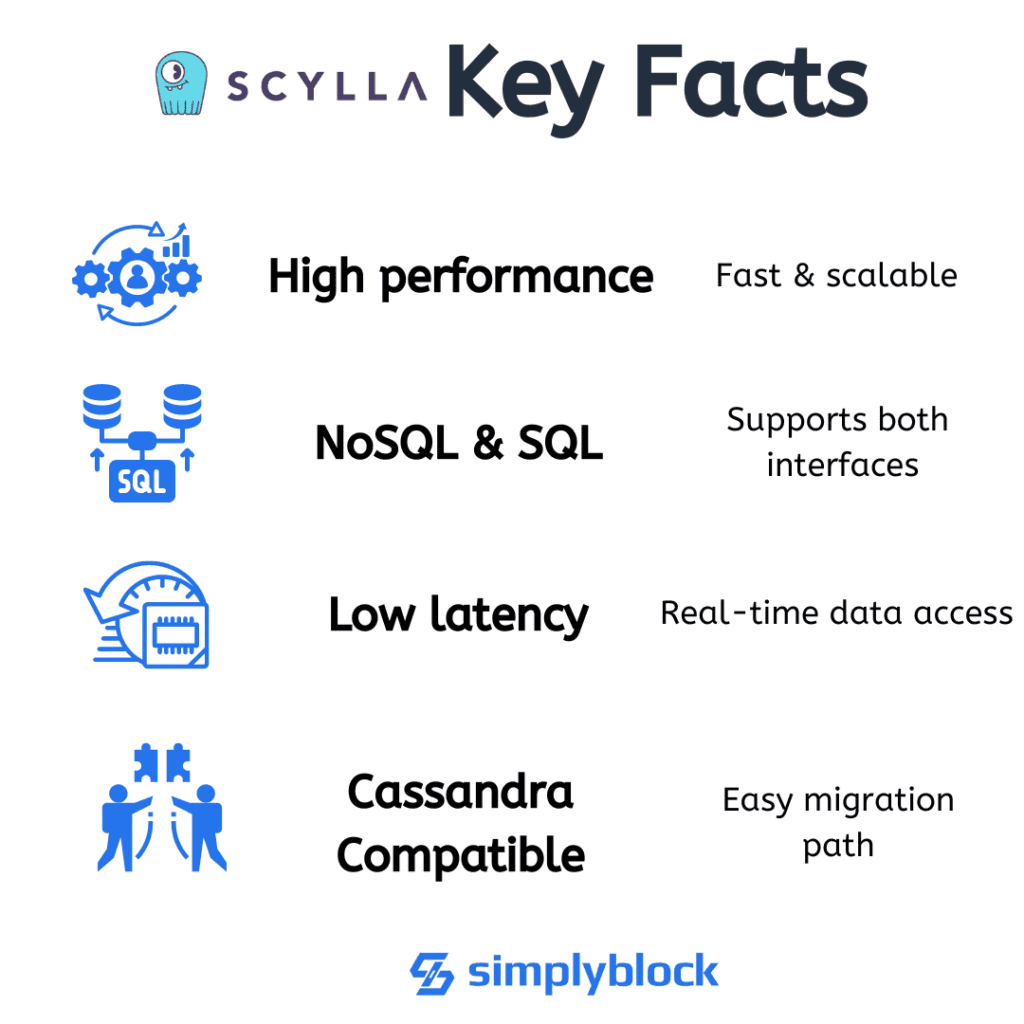ScyllaDB
Terms related to simplyblock
ScyllaDB is a high-performance, distributed NoSQL database designed for low-latency and high-throughput workloads. Fully compatible with Apache Cassandra and Amazon DynamoDB APIs, ScyllaDB re-architects the storage engine in C++ and leverages a shard-per-core design to maximize the capabilities of modern multi-core CPUs and NVMe storage. Its architecture makes it ideal for real-time big data, IoT, and time-series use cases.
How ScyllaDB Works
Unlike traditional NoSQL databases written in Java, ScyllaDB is implemented in C++ using the Seastar framework. It takes a shared-nothing, thread-per-core approach, allocating one shard per core and eliminating inter-thread context switching. Each core processes its own I/O and manages its own memory, delivering predictable latency even at high concurrency levels.
ScyllaDB’s internal scheduler prioritizes workload management, ensuring fair distribution of resources between different queries and users. This makes it suitable for latency-sensitive applications and real-time analytics, particularly when deployed on NVMe-powered infrastructure.
ScyllaDB vs Cassandra
Although API-compatible with Apache Cassandra, ScyllaDB offers substantial performance improvements through architectural differences. Here’s a breakdown:
| Feature | ScyllaDB | Apache Cassandra |
|---|---|---|
| Implementation Language | C++ | Java |
| Concurrency Model | Shard-per-core (Seastar) | Thread pool |
| Performance | Millions of IOPS, consistent latency | Lower IOPS, variable latency |
| Hardware Utilization | Efficient use of multi-core CPUs | Less CPU-aware |
| NVMe Optimization | Native support, zero-copy, polling | Limited NVMe awareness |
ScyllaDB can outperform Cassandra by 3x–10x under identical conditions, especially when run on NVMe-backed block storage.

ScyllaDB and NVMe Storage
ScyllaDB’s efficiency stems from its tight coupling with high-speed NVMe storage. Its I/O model uses asynchronous, direct I/O access with zero-copy mechanisms. These characteristics align with NVMe over TCP and software-defined storage, enabling line-rate throughput without CPU bottlenecks.
Simplyblock™ provides the ideal foundation for ScyllaDB deployments. With consistent sub-millisecond latencies and high IOPS via distributed NVMe, ScyllaDB clusters can scale without the storage becoming a limiting factor.
Storage Features Required by ScyllaDB
ScyllaDB stores massive volumes of data and depends heavily on I/O performance. Its key storage requirements include:
- High throughput: To handle millions of writes/reads per second
- Low latency: Critical for real-time workloads and SLAs
- Durability: ScyllaDB writes commit logs for crash recovery
- Backup/snapshot support: For disaster recovery and migration
- Scalability: Required for large-scale, multi-node clusters
Simplyblock’s erasure coding provides resilience while minimizing storage overhead. Volume-level encryption and snapshot support are built-in, aligning with ScyllaDB’s enterprise demands.
ScyllaDB in Kubernetes and Cloud-Native Architectures
ScyllaDB offers Scylla Operator for Kubernetes, which automates deployment and scaling. However, achieving optimal performance in containerized environments requires persistent volumes that meet I/O and replication needs.
Simplyblock integrates with Kubernetes through a CSI driver, enabling:
- Dynamic volume provisioning
- High-availability NVMe volumes
- Snapshot and clone functionality
- Cross-zone redundancy for fault tolerance
In hybrid or multi-cloud environments, ScyllaDB gains from simplyblock’s modular, adaptive, unified, shared-everything (MAUS) architecture, which enables seamless scale-out across heterogeneous infrastructure.
Use Cases of ScyllaDB
ScyllaDB powers some of the most demanding, latency-sensitive applications. Key industries and use cases include:
- Ad tech: Real-time bidding platforms
- Finance: Fraud detection, tick data ingestion
- Telecom: Subscriber data management
- IoT and time-series: Scalable sensor data ingestion
- Gaming: Real-time session tracking and state management
With NVMe-optimized SDS, ScyllaDB achieves the horizontal scalability and predictability required for these real-time workloads.
Relevant Simplyblock™ Features for ScyllaDB
ScyllaDB benefits significantly from features offered by simplyblock:
- NVMe-over-TCP protocol support
- Advanced erasure coding for data protection
- Kubernetes-native deployment via CSI
- Copy-on-write snapshots and clones
- High-density, multi-tenant environments with QoS
External Resources
- ScyllaDB Official Site
- Scylla GitHub Repository
- NoSQL Comparison on Wikipedia
- Scylla Operator for Kubernetes
- Cassandra vs ScyllaDB Performance Benchmarks
Questions and Answers
ScyllaDB is a high-performance, drop-in replacement for Apache Cassandra, written in C++ to fully utilize modern hardware. It offers significantly lower latency, better throughput, and reduced CPU usage—making it ideal for real-time applications and massive-scale data platforms.
Yes, ScyllaDB offers a Kubernetes Operator for seamless deployment and management. For production-grade performance, pair it with NVMe-powered Kubernetes storage to support fast data access, persistent volumes, and automatic failover.
ScyllaDB is optimized for low-latency, high-throughput environments and thrives with NVMe over TCP. This storage option maximizes IOPS and reduces read/write latency, especially for time-series and event-driven workloads.
Yes, ScyllaDB includes native encryption-at-rest for secure data storage. For enhanced compliance and isolation in multi-tenant setups, integrate with storage-level encryption that allows per-volume key management and secure Kubernetes integration.
Absolutely. ScyllaDB is designed for massive throughput and low-latency use cases like recommendation engines, IoT platforms, and ad tech. Combining it with software-defined storage ensures scalable performance with minimal infrastructure overhead.
